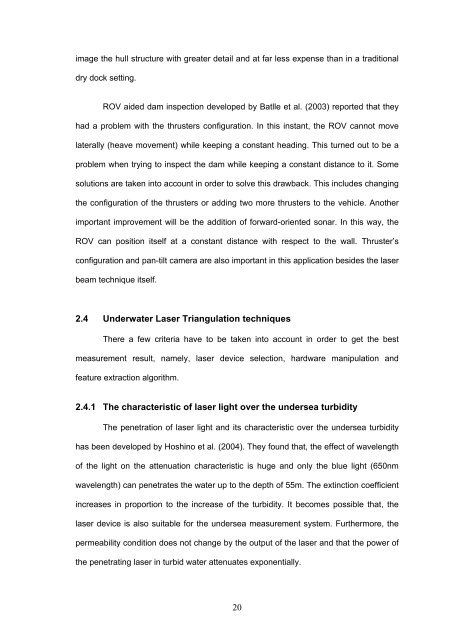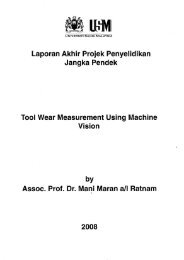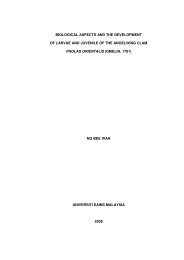development of a vision system for ship hull ... - ePrints@USM
development of a vision system for ship hull ... - ePrints@USM
development of a vision system for ship hull ... - ePrints@USM
Create successful ePaper yourself
Turn your PDF publications into a flip-book with our unique Google optimized e-Paper software.
image the <strong>hull</strong> structure with greater detail and at far less expense than in a traditionaldry dock setting.ROV aided dam inspection developed by Batlle et al. (2003) reported that theyhad a problem with the thrusters configuration. In this instant, the ROV cannot movelaterally (heave movement) while keeping a constant heading. This turned out to be aproblem when trying to inspect the dam while keeping a constant distance to it. Somesolutions are taken into account in order to solve this drawback. This includes changingthe configuration <strong>of</strong> the thrusters or adding two more thrusters to the vehicle. Anotherimportant improvement will be the addition <strong>of</strong> <strong>for</strong>ward-oriented sonar. In this way, theROV can position itself at a constant distance with respect to the wall. Thruster’sconfiguration and pan-tilt camera are also important in this application besides the laserbeam technique itself.2.4 Underwater Laser Triangulation techniquesThere a few criteria have to be taken into account in order to get the bestmeasurement result, namely, laser device selection, hardware manipulation andfeature extraction algorithm.2.4.1 The characteristic <strong>of</strong> laser light over the undersea turbidityThe penetration <strong>of</strong> laser light and its characteristic over the undersea turbidityhas been developed by Hoshino et al. (2004). They found that, the effect <strong>of</strong> wavelength<strong>of</strong> the light on the attenuation characteristic is huge and only the blue light (650nmwavelength) can penetrates the water up to the depth <strong>of</strong> 55m. The extinction coefficientincreases in proportion to the increase <strong>of</strong> the turbidity. It becomes possible that, thelaser device is also suitable <strong>for</strong> the undersea measurement <strong>system</strong>. Furthermore, thepermeability condition does not change by the output <strong>of</strong> the laser and that the power <strong>of</strong>the penetrating laser in turbid water attenuates exponentially.20
















